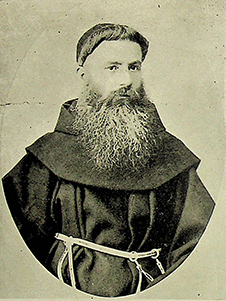15.11.2022

The Armenian Genocide Museum-Institute (AGMI) received a package of materials for archival preservation from the Ministry of Foreign Affairs of the Republic of Armenia in June this year. It mainly consisted of documents in Italian. As reported in the letter attached, sent by the Ministry of Foreign Affairs of the Republic of Armenia, a gentleman named Mr. Talal Khrais, the founder of the Italo-Arab “Assadakah” association, handed these archival materials to Mrs. Tsovinar Hambardzumyan, Ambassador Extraordinary and Plenipotentiary of the Republic of Armenia in the Italian Republic. According to Mr. Khrais, a brick maker named Salvatore Gargano discovered the said archival materials during renovation works carried out on the monastery of Oriolo Romano (a commune in Viterbo, Lazio)
[1]. These archival materials are a collection of historical documents amassed to examine the circumstances of Italian-born Franciscan friar Salvatore Lilli’s martyrdom and his subsequent beatification by the Catholic Church.
The materials consist of historical records, one letter from Father Salvatore addressed to the then Pope Pius IX (1846-1878), various ecclesiastical and secular officials, recorded testimonies collected during the investigation of the circumstances of Salvatore Lilli's martyrdom and photographs of witnesses. In those records, Salvatore Lilli, as an eyewitness, also described the repressions carried out by the Ottoman Empire against the Armenian population.
Salvatore Lilli, the son of Vincenzo and Annunziata Lilli, was born in Comune di Cappadocia in the L'Aquila province of the Abruzzo region of Central Italy on June 19, 1853. He was baptised on the same day in the parish church dedicated to the Armenian martyr San Biagio (St. Blaise of Sebaste, martyred in 316 in Sebastia). He became a Franciscan monk at a young age in 1870-1871. He went to Asia Minor as a missionary in 1873 and was appointed spiritual leader of Mujukderesi. He was killed by Ottoman soldiers along with seven Armenian companions on November 19, 1895. The local Franciscan congregation had received threats from the Ottoman military authorities for a long time. It had become so dangerous for them to stay in the region that, in one of his letters addressed to Father Dionisio in Marash, Father Salvatore asked for help in taking measures to somehow ensure their safety. Father Salvatore had heard several times that, behind the order issued to the Franciscan congregation and the monastery servants to leave the monastery, there was the intention of secretly killing them somewhere along the journey. In the end, the goal was achieved. Colonel Mazhar Bey set up an army detachment near Mujukderesi and entered the monastery. Father Salvatore told them to take everything they wanted, but to leave the people alive. In response to this, the commander replied, “I came only to take your life.” They began to torture Father Salvatore, injuring his thigh, then repeatedly offered to convert to Islam to him and his companions, who decided not to leave Father Salvatore alone. The latter were mostly servants of the monastery who the Turks decided to transport to Marash roped together. All refused to renounce Christianity and accept Islam.
Aghassi (Karapet Ter-Sargissian, 1871-1941), a Hnchak party activist from Hadjin, who wrote the history of the Zeitun rebellion, describes Father Salvatore Lilli and his companions’ martyrdom, dedicating to the latter Chapter XVI of his book (8 pages)
[2]. Aghassi describes Salvatore Lilli’s martyrdom as follows:
"Mazhar Bey, with his troops, crossed the Kursil stream on foot, taking a short route. Father Salvatore was invited to accept Islam somewhere between of the two streams, where there were two Muslim houses, near the Kharlagian mill. He refused. Mazhar bey then ordered the soldiers to kill him and his Armenian friends, piled the corpses on top of each other and set them on fire. Martiros' ten-year-old daughter Mariam, who was not killed by the Turks, showed where it happened…"[3].
Evidences of Father Salvatore Lilli's martyrdom circumstances were also found in documents from the Vatican's Secret Archives, where it is specifically stated that he was martyred in Yenicekale, a place near Marash. In one of the letters dated January 1896 addressed to Apostolic Nuncio Henry Victor Altmaier (assigned to the Middle East), Father Dionisio d'Albano reported that Father Salvatore chose not to leave the community under his spiritual leadership. During the harshest period of tribulations of the Abdul Hamid II massacres perpetrated against the Armenians , he operated to provide any necessary spiritual and material help to the believers in the region
[4].
On October 3, 1982, Pope John Paul II beatified Salvatore Lilli and the seven companions who were martyred with him and November 19 was set as their commemorative and feast day. In fact, what was handed over to AGMI is a dossier of documents compiled over decades, consisting of 208 sheets (earliest dated October 10, 1894, latest May 22, 1944, relating to Salvatore Lilli’s beatification, beginning with his personal letter and the period immediately following his martyrdom) and, according to our classification, consists of 24 separate items in Italian, French, Latin and Turkish written in Armenian script, dated in different years.

La Missione Francescana di Terra Santa nei recenti casi d'Armenia, 1896.
The Franciscan Holy Land Mission on recent events in Armenia, 1896.

The first page of one of the materials concerning the circumstances of Father Salvatore's martyrdom, with the inscription
"Relazioni sul Martirio del R. P. Salvatore da Cappadoccia".

A panorama of the commune of Cappadocia in Italy’s Abruzzo region
Shushan Khachatryan PhD,
Senior researcher, head of Documentation and Research Department of Victims and Survivors of the Armenian Genocide, AGMI
[1] Probably the St. Antonio of Padua monastery.
[2] Աղասի, Զէյթուն եւ իր շրջակաները, տպարան Շիրակ, Հաննէսեան եղբ., Պէյրութ, 1968, էջ 239-247 [Aghassi, Zeitun and the Surroundings, Shirak printing house, Hannessian brothers, Beirut, 1968, pp. 239-247].
[3] Ibid, page 244-245.
[4] La Questione Armena, Vol. 1, 1894-1896. Documenti dell’Archivio Segreto Vaticano (ASV), a cura di Georges-Henri Ruyssen SJ, Edizioni Orientalia Christiana, Valore Italiano/Lilamé, pp. 243, 263, 264, 267, 285, 315.





